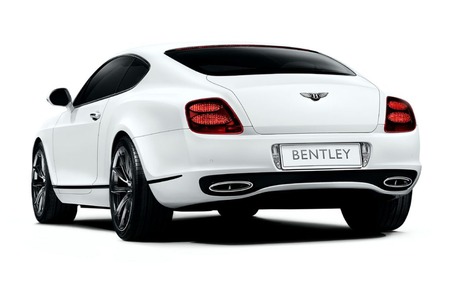Bentley Continental Supersports revealed

Set to debut at the 2009 Geneva Auto Show, the Bentley Continental Supersports is being touted as the fastest and most powerful Bentley ever created. Based on the Continental GT, this extreme Bentley gets more power, loses some weight and seats only two. Set to go on sale by late 2009, the Supersports can also run on the E85 petrol-ethanol fuel available in America, thereby touting some dubious green credentials.

The Continental Supersports began as an ‘under the radar’ project exploring the possibilities of weight reduction on the Continental GT but with more power and torque. A largely experimental process crystallised over a period of 24 months into an official new car programme, driven by the passion and enthusiasm of a small group of Bentley engineers and designers.
The results are dramatic. With 621 hp and new ‘Quickshift’ transmission that halves shift times, the Supersports sets new performance benchmarks for Bentley. It accelerates from 0-100 kph in 3.9 seconds onto a top speed of 329 kph.
Supercar performance is complemented by an array of chassis enhancements including retuned steering and suspension, utilising lighter weight components, retuned dampers and anti-roll bars.
Agility is further sharpened by the 40:60 rear-biased torque split for the all-wheel drive system, a wider rear track, bespoke lightweight 20-inch alloy wheels and a unique electronic stability system.
Carbon ceramic brakes are standard fitment, benefiting steering response, grip and ride comfort, while saving weight. Overall, the engineering team have achieved a weight reduction of 110 kg compared with the Continental GT Speed.
The evolution of the Supersports’ design is very much a case of ‘form following function’ with new purposeful sculptural forms signalling the engineering changes beneath the skin.
For example, the increased power and torque of the W12 engine necessitated additional airflow to the twin turbocharger intercoolers and cooling system. Bentley’s designers responded with a purposeful and dramatic style that features large vertical intake apertures and twin bonnet vents.
Similarly, new flared rear wings that accommodate the 50 mm wider rear track are designed to emphasise the powerful stance of this ultra-high performance coupe. The resultant Supersports style combines the looks of the iconic Continental GT with a new and distinctive appearance that reflects its more extreme character.
The Supersports is further distinguished from its Continental coupe stable mates by a unique dark-smoked steel finish to all exterior ‘brightware’, including front grilles, lamp bezels, window surrounds and wheels. A complex ‘Physical Vapour Deposition’ process is applied to all stainless steel components to give a lustrous and highly durable finish. A car industry first, this process is normally used as a coating on industrial tools, watches and even hip replacement joints.
Fully embracing the extreme spirit of the Supersports, Bentley’s interior designers have created a unique ambience. The cockpit represents a dramatic re-interpretation of Bentley interior design in which carbon-fibre and Alcantara not only convey a sporting and contemporary style but also reduce weight.
The Supersports is a strict two-seater featuring all-new lightweight sports seats with carbon-fibre clamshell rear panels. In the rear compartment, the seats are replaced by a stowage deck with a carbon-fibre luggage retaining beam.
The new interior also provides a showcase for the skills of Bentley’s craftsmen and women at the company’s factory in Crewe, England. Signature premium grade leather and brightware are complemented by carbon-fibre panels, replacing traditional wood veneers.
The Continental Supersports is capable of running on either petrol and E85 biofuel or any combination of the two. E85 biofuel can offer a reduction of up to 70 per cent in CO2 emissions on a ‘well-to-wheel’ basis.
Well-to-wheel is a measurement of a fuel’s net CO2 contribution to the atmosphere, not just tailpipe emissions. It is a way of quantifying how much CO2 a fuel emits from its growth or extraction (well) to its combustion or deployment (wheel). It includes refinement, distillation and transport of the fuel.
The fuel supply system detects the blending ratio of the fuel in the tank and ensures that power and torque remain constant regardless of the ratio of petrol to biofuel. The result is seamless power delivery in the Bentley tradition.
The ‘Supersports’ name is inspired by the original two-seater 3-litre Supersports model introduced in 1925, itself an evolution of the 3-litre Speed. The lightweight, 85 hp Supersports was the first production Bentley to reach 100 mph and was also renowned for the application of Le Mans-winning race technology.




Comments
BJD(Boris)
Ethanol and crop-based bio-fuels get thumbs down frm me. its just not practical. Studies show that to power every car in the US with Ethanol, corn fields bigger than the US itself would be needed! I support hydrogen fuel cells and electric power as the future auto fuel.
Besides that, I like this car.
eazy_mas
It also going to increase food prices which is very bad for the people.
But electic and hydrogen fuel cells are not as effective as petrol. If you see in the bigger picture of input in making the energy vs output oil will beat it. That is why we still use oil in the past 50 year or more.
BJD(Boris)
but oil’s not gonna last. so something has to replace it once it dries up.
sohi
DEAR MASH AND USERS PLEASE HELP ME IF U HAVING BUDGET FOR A CAR UPTO MAX 125 THOUSAND DIRHAMS WHAT CAR WILL U BUY PLEASE ANSWER ME?????
BJD(Boris)
what type of car do ya want? what features… something or do ya have some options in mind?
Mashfique Hussain Chowdhury
sohi, come and join the forums at http://www.drivearabia.com/myride
better to start a discussion there